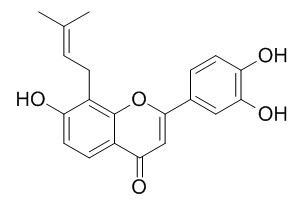Corylifol C
Corylifol C and, to a lesser extent, xanthoangelol are potent protein kinase inhibitors (inhibitory concentration 50% values for epidermal growth factor receptor (EGFR): 1.1 and 4.4 × 10(-6) μg/ml, respectively).
Inquire / Order:
manager@chemfaces.com
Technical Inquiries:
service@chemfaces.com
Tel:
+86-27-84237783
Fax:
+86-27-84254680
Address:
1 Building, No. 83, CheCheng Rd., Wuhan Economic and Technological Development Zone, Wuhan, Hubei 430056, PRC
Providing storage is as stated on the product vial and the vial is kept tightly sealed, the product can be stored for up to
24 months(2-8C).
Wherever possible, you should prepare and use solutions on the same day. However, if you need to make up stock solutions in advance, we recommend that you store the solution as aliquots in tightly sealed vials at -20C. Generally, these will be useable for up to two weeks. Before use, and prior to opening the vial we recommend that you allow your product to equilibrate to room temperature for at least 1 hour.
Need more advice on solubility, usage and handling? Please email to: service@chemfaces.com
The packaging of the product may have turned upside down during transportation, resulting in the natural compounds adhering to the neck or cap of the vial. take the vial out of its packaging and gently shake to let the compounds fall to the bottom of the vial. for liquid products, centrifuge at 200-500 RPM to gather the liquid at the bottom of the vial. try to avoid loss or contamination during handling.
Biomed Chromatogr.2022, 36(11):e5462.
Phytomedicine.2023, 117:154929.
Int J Mol Sci.2019, 20(21):E5488
Sci Rep.2017, 7:467-479
Journal of Pharmaceutical Investigation2024, 024-00662-1.
J Nat Med.2018, 72(3):734-744
LWT-Food Sci Technol2020, 109163
J Insect Sci.2020, 20(5):18.
Chemistry of Plant Raw Materials2022, 20220210569.
Nat Prod Commun.2014, 9(5):679-82
Related and Featured Products
J Pharm Pharmacol. 2013 Sep;65(9):1393-408.
Compounds isolated from Psoralea corylifolia seeds inhibit protein kinase activity and induce apoptotic cell death in mammalian cells.[Pubmed:
23927478]
Psoralea corylifolia is a plant widely used in traditional Chinese medicine, e.g. for its chemopreventive effect. To identify active substances responsible for this effect, we investigated pharmacological effects of 11 compounds isolated from the seeds of this plant (newly described substances: 7, 2', 4'-trihydroxy-3-arylcoumarin and psoracoumestan).
METHODS AND RESULTS:
The influence of distinct compounds on different signal transduction pathways (cell proliferation, survival, angiogenesis and metastasis) was screened via analysis of the activity of 24 protein kinases, mitogen activated protein kinase phosphorylation via Western blot, cytotoxicity was shown using the 3-(4,5-dimethylthiazol-2-yl)-2,5-diphenyltetrazolium bromide assay and determination of caspase activity. Oxidative stress was detected via 2',7'-dichlorofluorescein fluorescence.
Some compounds showed cytotoxic effects (H4IIE, Hct116, C6 cells) mainly mediated via induction of apoptosis. Distinct compounds caused a strong inhibition of MAPK/ERK kinase (MEK) phosphorylation, weak effects on extracellular-signal regulated kinase (ERK) phosphorylation and no significant effect on p38 and c-Jun amino-terminal kinase. Corylifol C and, to a lesser extent, xanthoangelol are potent protein kinase inhibitors (inhibitory concentration 50% values for epidermal growth factor receptor (EGFR): 1.1 and 4.4 × 10(-6) μg/ml, respectively). Because EGFR, MEK and ERK are kinases involved in cellular proliferation, an inhibition of these enzymes may be useful to cause chemopreventive effects.
CONCLUSIONS:
Distinct compounds isolated from P. corylifolia showed a high potential to influence cellular pathways, e.g. by inhibition of protein kinases that may be interesting for pharmacological purposes.



